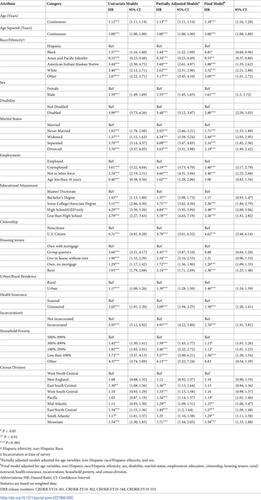Our official English website, www.x-mol.net, welcomes your
feedback! (Note: you will need to create a separate account there.)
Socioeconomic risk factors for fatal opioid overdoses in the United States: Findings from the Mortality Disparities in American Communities Study (MDAC).
PLOS ONE ( IF 2.9 ) Pub Date : 2020-01-17 , DOI: 10.1371/journal.pone.0227966 Sean F Altekruse 1 , Candace M Cosgrove 2 , William C Altekruse 3 , Richard A Jenkins 4 , Carlos Blanco 4
PLOS ONE ( IF 2.9 ) Pub Date : 2020-01-17 , DOI: 10.1371/journal.pone.0227966 Sean F Altekruse 1 , Candace M Cosgrove 2 , William C Altekruse 3 , Richard A Jenkins 4 , Carlos Blanco 4
Affiliation

|
BACKGROUND
Understanding relationships between individual-level demographic, socioeconomic status (SES) and U.S. opioid fatalities can inform interventions in response to this crisis.
METHODS
The Mortality Disparities in American Community Study (MDAC) links nearly 4 million 2008 American Community Survey responses to the 2008-2015 National Death Index. Univariate and multivariable models were used to estimate opioid overdose fatality hazard ratios (HR) and 95% confidence intervals (CI).
RESULTS
Opioid overdose was an overrepresented cause of death among people 10 to 59 years of age. In multivariable analysis, compared to Hispanics, Whites and American Indians/Alaska Natives had elevated risk (HR = 2.52, CI:2.21-2.88) and (HR = 1.88, CI:1.35-2.62), respectively. Compared to women, men were at-risk (HR = 1.61, CI:1.50-1.72). People who were disabled were at higher risk than those who were not (HR = 2.80, CI:2.59-3.03). Risk was higher among widowed than married (HR = 2.44, CI:2.03-2.95) and unemployed than employed individuals (HR = 2.46, CI:2.17-2.79). Compared to adults with graduate degrees, those with high school only were at-risk (HR = 2.48, CI:2.00-3.06). Citizens were more likely than noncitizens to die from this cause (HR = 4.62, CI:3.48-6.14). Compared to people who owned homes with mortgages, those who rented had higher HRs (HR = 1.36, CI:1.25-1.48). Non-rural residents had higher risk than rural residents (HR = 1.46, CI:1.34, 1.59). Compared to respective referent groups, people without health insurance (HR = 1.30, CI:1.20-1.41) and people who were incarcerated were more likely to die from opioid overdoses (HR = 2.70, CI:1.91-3.81). Compared to people living in households at least five-times above the poverty line, people who lived in poverty were more likely to die from this cause (HR = 1.36, CI:1.20-1.54). Compared to people living in West North Central states, HRs were highest among those in South Atlantic (HR = 1.29, CI:1.11, 1.50) and Mountain states (HR = 1.58, CI:1.33, 1.88).
DISCUSSION
Opioid fatality was associated with indicators of low SES. The findings may help to target prevention, treatment and rehabilitation efforts to vulnerable groups.
中文翻译:

美国致命阿片类药物过量的社会经济风险因素:美国社区研究(MDAC)的死亡率差异发现。
背景技术了解个体水平的人口统计学,社会经济地位(SES)与美国阿片类药物死亡人数之间的关系可以为应对这一危机提供信息。方法美国社区研究中的死亡率差异(MDAC)将近400万美国社区调查与2008-2015国家死亡指数相联系。单变量和多变量模型用于估计阿片类药物过量致死危险比(HR)和95%置信区间(CI)。结果阿片类药物过量是10至59岁人群中死亡的一个典型代表。在多变量分析中,与西班牙裔美国人相比,白人和美洲印第安人/阿拉斯加土著人的风险分别较高(HR = 2.52,CI:2.21-2.88)和(HR = 1.88,CI:1.35-2.62)。与女性相比,男性处于危险之中(HR = 1.61,CI:1.50-1.72)。残疾人比没有残疾人的风险更高(HR = 2.80,CI:2.59-3.03)。丧偶者的风险高于已婚者(HR = 2.44,CI:2.03-2.95),失业者的就业率高于就业个体(HR = 2.46,CI:2.17-2.79)。与拥有研究生学位的成年人相比,只有高中阶段的成年人处于危险中(HR = 2.48,CI:2.00-3.06)。公民比非公民死亡的可能性更大(HR = 4.62,CI:3.48-6.14)。与拥有抵押房屋的人相比,出租房屋的人的HR更高(HR = 1.36,CI:1.25-1.48)。非农村居民的风险高于农村居民(HR = 1.46,CI:1.34,1.59)。与相应的参考人群相比,没有医疗保险的人(HR = 1.30,CI:1.20-1.41)和被监禁的人死于阿片类药物过量的可能性更高(HR = 2.70,CI:1.91-3.81)。与生活在贫困线以上至少五倍的家庭相比,生活在贫困中的人更有可能死于这一原因(HR = 1.36,CI:1.20-1.54)。与居住在西北北部中部各州的人相比,HR最高的是南大西洋(HR = 1.29,CI:1.11,1.50)和山区州(HR = 1.58,CI:1.33,1.88)。讨论阿片类药物死亡与低SES指标有关。这些发现可能有助于将预防,治疗和康复工作的目标对准弱势群体。88)。讨论阿片类药物死亡与低SES指标有关。这些发现可能有助于将预防,治疗和康复工作的目标对准弱势群体。88)。讨论阿片类药物死亡与低SES指标有关。这些发现可能有助于将预防,治疗和康复工作的目标对准弱势群体。
更新日期:2020-01-21
中文翻译:

美国致命阿片类药物过量的社会经济风险因素:美国社区研究(MDAC)的死亡率差异发现。
背景技术了解个体水平的人口统计学,社会经济地位(SES)与美国阿片类药物死亡人数之间的关系可以为应对这一危机提供信息。方法美国社区研究中的死亡率差异(MDAC)将近400万美国社区调查与2008-2015国家死亡指数相联系。单变量和多变量模型用于估计阿片类药物过量致死危险比(HR)和95%置信区间(CI)。结果阿片类药物过量是10至59岁人群中死亡的一个典型代表。在多变量分析中,与西班牙裔美国人相比,白人和美洲印第安人/阿拉斯加土著人的风险分别较高(HR = 2.52,CI:2.21-2.88)和(HR = 1.88,CI:1.35-2.62)。与女性相比,男性处于危险之中(HR = 1.61,CI:1.50-1.72)。残疾人比没有残疾人的风险更高(HR = 2.80,CI:2.59-3.03)。丧偶者的风险高于已婚者(HR = 2.44,CI:2.03-2.95),失业者的就业率高于就业个体(HR = 2.46,CI:2.17-2.79)。与拥有研究生学位的成年人相比,只有高中阶段的成年人处于危险中(HR = 2.48,CI:2.00-3.06)。公民比非公民死亡的可能性更大(HR = 4.62,CI:3.48-6.14)。与拥有抵押房屋的人相比,出租房屋的人的HR更高(HR = 1.36,CI:1.25-1.48)。非农村居民的风险高于农村居民(HR = 1.46,CI:1.34,1.59)。与相应的参考人群相比,没有医疗保险的人(HR = 1.30,CI:1.20-1.41)和被监禁的人死于阿片类药物过量的可能性更高(HR = 2.70,CI:1.91-3.81)。与生活在贫困线以上至少五倍的家庭相比,生活在贫困中的人更有可能死于这一原因(HR = 1.36,CI:1.20-1.54)。与居住在西北北部中部各州的人相比,HR最高的是南大西洋(HR = 1.29,CI:1.11,1.50)和山区州(HR = 1.58,CI:1.33,1.88)。讨论阿片类药物死亡与低SES指标有关。这些发现可能有助于将预防,治疗和康复工作的目标对准弱势群体。88)。讨论阿片类药物死亡与低SES指标有关。这些发现可能有助于将预防,治疗和康复工作的目标对准弱势群体。88)。讨论阿片类药物死亡与低SES指标有关。这些发现可能有助于将预防,治疗和康复工作的目标对准弱势群体。











































 京公网安备 11010802027423号
京公网安备 11010802027423号